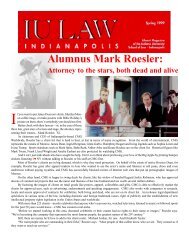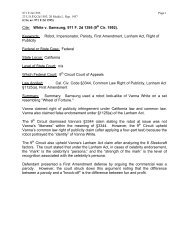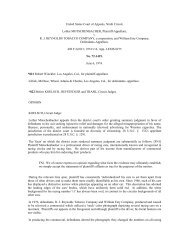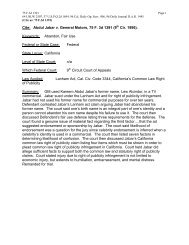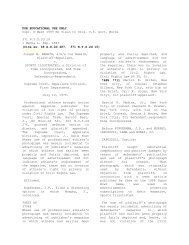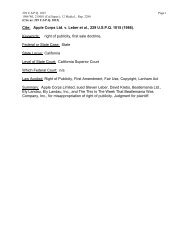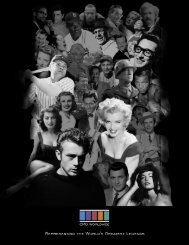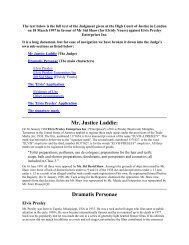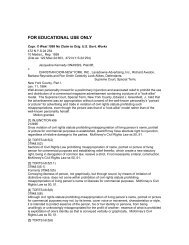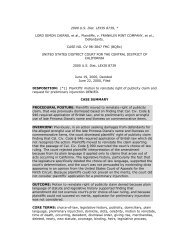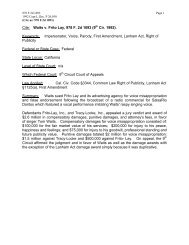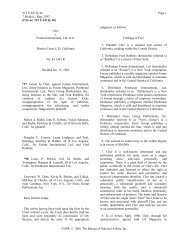MLK Jr. Center v American Heritage Products.pdf - Mark Roesler
MLK Jr. Center v American Heritage Products.pdf - Mark Roesler
MLK Jr. Center v American Heritage Products.pdf - Mark Roesler
Create successful ePaper yourself
Turn your PDF publications into a flip-book with our unique Google optimized e-Paper software.
LEXSEE 296 S.E.2d 697<br />
MARTIN LUTHER KING, JR. CENTER FOR SOCIAL CHANGE, INC. et al.<br />
v. AMERICAN HERITAGE PRODUCTS, INC. et al.<br />
PRIOR HISTORY:<br />
[***1]<br />
No. 38748<br />
Supreme Court of Georgia<br />
250 Ga. 135; 296 S.E.2d 697; 1982 Ga. LEXIS 1229; 8 Media<br />
L. Rep. 2377; 216 U.S.P.Q. (BNA) 711<br />
October 28, 1982, Decided<br />
Certified questions from the United States Court of Appeals for the Eleventh Circuit.<br />
DISPOSITION:<br />
Certified questions 1 and 2 answered in the affirmative, question 3 Answered in the<br />
negative, and question 4 not answered.<br />
COUNSEL:<br />
Harmon, Smith & Bridges, Archer D. Smith III, John M. Leiter, for appellants.<br />
Ruppert, Bronson & Chicarelli, James D. Ruppert, for appellees.<br />
JUDGES:<br />
Hill, Presiding Justice. All the Justices concur, except Weltner, J., who concurs<br />
specially.<br />
OPINION BY: HILL<br />
OPINION:<br />
[*135] [**698] These are certified questions regarding the "right of publicity." The<br />
certification comes from the United States Court of Appeals for the Eleventh Circuit.<br />
Code Ann. @ 24-3902; see Miree v. United States of America, 242 Ga. 126, 131-133<br />
(249 SE2d 573) (1978). The facts upon which the questions arise are as follows: n1<br />
- - - - - - - - - - - - - - - - - -Footnotes- - - - - - - - - - - - - - - - - -<br />
n1 The statement of facts is taken almost verbatim from the Court of Appeals'<br />
certification. For convenience, the parties will be identified as they appeared in the<br />
district court.<br />
- - - - - - - - - - - - - - - - -End Footnotes- - - - - - - - - - - - - - - - -<br />
[***2]
The plaintiffs are the Martin Luther King, <strong>Jr</strong>. <strong>Center</strong> for Social Change (the 250 Ga.<br />
135, *135; 296 S.E.2d 697, **698; 1982 Ga. LEXIS 1229, ***2; 8 Media L. Rep. 2377<br />
<strong>Center</strong>), n2 Coretta Scott King, as administratrix of Dr. King's estate, and Motown<br />
Record Corporation, the assignee of the rights to several of Dr. King's copyrighted<br />
speeches. Defendant James F. Bolen is the sole proprietor of a business known as B &<br />
S Sales, which manufactures and sells various plastic products as funeral accessories.<br />
Defendant James E. Bolen, the son of James F. Bolen, developed the concept of<br />
marketing a plastic bust of Dr. Martin Luther King, <strong>Jr</strong>., and formed a company, B & S<br />
Enterprises, to sell the busts, which would be manufactured by B & S Sales. B & S<br />
Enterprises was later incorporated under the name of <strong>American</strong> <strong>Heritage</strong> <strong>Products</strong>, Inc.<br />
- - - - - - - - - - - - - - - - - -Footnotes- - - - - - - - - - - - - - - - - -<br />
n2 The <strong>Center</strong> is a non-profit corporation which seeks to promote the ideals of Dr.<br />
King.<br />
- - - - - - - - - - - - - - - - -End Footnotes- - - - - - - - - - - - - - - - -<br />
Although Bolen sought the endorsement and participation of the Martin Luther King, <strong>Jr</strong>.<br />
<strong>Center</strong> for Social Change, Inc., in the marketing of the bust, the <strong>Center</strong> refused Bolen's<br />
offer. Bolen [***3] pursued the idea, nevertheless, hiring an artist to prepare a mold and<br />
an agent to handle the promotion of the product. Defendant took out two half-page<br />
advertisements in the November and December 1980 issues of Ebony magazine, which<br />
purported to offer the bust as "an exclusive memorial" and "an opportunity to support the<br />
Martin Luther King, <strong>Jr</strong>., <strong>Center</strong> for Social Change." The advertisement stated that "a<br />
contribution from your order goes to the King <strong>Center</strong> for Social Change." Out of the<br />
$29.95 purchase price, defendant Bolen testified he set aside 3% or $ .90, as a<br />
contribution to the <strong>Center</strong>. The advertisement also offered "free" with the purchase of<br />
the bust a booklet about the life of Dr. King entitled "A Tribute to Dr. Martin Luther King,<br />
<strong>Jr</strong>."<br />
In addition to the two advertisements in Ebony, defendant [*136] published a brochure<br />
or pamphlet which was inserted in 80,000 copies of newspapers across the country.<br />
The brochure reiterated what was stated in the magazine advertisements, and also<br />
contained photographs of Dr. King and excerpts from his copyrighted speeches. The<br />
brochure promised that each "memorial" (bust) is accompanied by a Certificate of<br />
Appreciation "testifying [***4] that a contribution has been made to the Martin Luther<br />
King, <strong>Jr</strong>., <strong>Center</strong> for Social Change."<br />
Defendant James E. Bolen testified that he created a trust fund for that portion of<br />
[**699] the earnings which was to be contributed to the <strong>Center</strong>. The trust fund<br />
agreement, however, was never executed, and James E. Bolen testified that this was<br />
due to the plaintiffs' attorneys' request to cease and desist from all activities in issue.<br />
Testimony in the district court disclosed that money had been tendered to the <strong>Center</strong>,<br />
but was not accepted by its governing board. Also, the district court found that, as of the<br />
date of the preliminary injunction, the defendants had sold approximately 200 busts and<br />
had outstanding orders for 23 more.<br />
On November 21, 1980, and December 19, 1980, the plaintiffs demanded that the<br />
Bolens cease and desist from further advertisements and sales of the bust, and on<br />
December 31, 1980, the plaintiffs filed a complaint in the United States District Court for
the Northern District of Georgia. The district court held a hearing on the plaintiffs' motion<br />
for a preliminary injunction and the defendants' motion to dismiss the complaint. The<br />
motion to dismiss was denied [***5] and the motion for a preliminary injunction was<br />
granted in part and denied in part. The motion for an injunction sought (1) an end to the<br />
use of the <strong>Center</strong>'s name in advertising and marketing the busts, (2) restraint of any<br />
further copyright infringement and (3) an end to the manufacture and sale of the plastic<br />
busts. The defendants agreed to discontinue the use of the <strong>Center</strong>'s name in further<br />
promotion. Therefore, the court granted this part of the injunction. The district court<br />
found that the defendants had infringed the King copyrights and enjoined all further use<br />
of the copyrighted material.<br />
In ruling on the third request for injunction, the court confronted the plaintiffs' claim that<br />
the manufacture and sale of the busts violated Dr. King's right of publicity which had<br />
passed to his heirs upon Dr. King's death. The defendants contended that no such right<br />
existed, and hence, an injunction should not issue. The district court concluded that it<br />
was not necessary to determine whether the "right of publicity" was devisable in Georgia<br />
because Dr. King did not commercially exploit this right during his lifetime. As found by<br />
the district court, the evidence of exploitation by [***6] Dr. King came from his sister's<br />
affidavit which stated that he had received "thousands of [*137] dollars in the form of<br />
honorariums from the use of his name, likeness, literary compositions, and speeches."<br />
The district court further found that "Dr. King apparently sold his copyrights in several<br />
speeches to Motown Records Corporation." Martin Luther King, <strong>Jr</strong>. <strong>Center</strong> for Social<br />
Change v. <strong>American</strong> <strong>Heritage</strong> <strong>Products</strong>, 508 FSupp. 854 (N.D. Ga. 1981).<br />
On plaintiffs' appeal of the partial denial of the preliminary injunction, the Eleventh<br />
Circuit Court of Appeals has certified the following questions:<br />
(1) Is the "right of publicity" recognized in Georgia as a right distinct from the right of<br />
privacy?<br />
(2) If the answer to question (1) is affirmative, does the "right to publicity" survive the<br />
death of its owner? Specifically, is the right inheritable and devisable?<br />
(3) If the answer to question (2) is also affirmative, must the owner have commercially<br />
exploited the right before it can survive his death?<br />
(4) Assuming the affirmative answers to questions (1), (2) and (3), what is the<br />
guideline to be followed in defining commercial exploitation and what are the evidentiary<br />
prerequisites [***7] to a showing of commercial exploitation?<br />
As noted by the Eleventh Circuit, this case raises questions concerning the laws of<br />
Georgia as to which there are no controlling precedents directly on point. In addition to<br />
being novel in this jurisdiction, the questions are legally alluring. Under these twin<br />
circumstances, it is necessary in the first instance to consider how the answers to the<br />
questions apply to other fact situations, and tempting in the second instance to include<br />
those considerations in writing. Hopefully having considered the various ramifications,<br />
we will resist to the extent possible the temptation to answer more than has been asked.<br />
[**700] The right of publicity may be defined as a celebrity's right to the exclusive use<br />
of his or her name and likeness. Price v. Hal Roach Studios, 400 FSupp. 836, 843 (S. D.<br />
N. Y. 1975); Estate of Presley v. Russen, 513 FSupp. 1339, 1353 (D. N. J. 1981), and
cases cited. The right is most often asserted by or on behalf of professional athletes,<br />
comedians, actors and actresses, and other entertainers. This case involves none of<br />
those occupations. As is known to all, from 1955 until he was assassinated on April 4,<br />
1968, Dr. [***8] King, a Baptist minister by profession, was the foremost leader of the<br />
civil rights movement in the United States. He was awarded the Nobel Prize for Peace<br />
in 1964. Although not a public official, Dr. King was a public figure, and we deal in this<br />
opinion with public figures who are neither public officials nor entertainers. Within this<br />
framework, we turn to the questions [*138] posed.<br />
1. Is the "right of publicity" recognized in Georgia as a right distinct from the right of<br />
privacy?<br />
Georgia has long recognized the right of privacy. Following denial of the existence of<br />
the right of privacy in a controversial decision by the New York Court of Appeals in<br />
Roberson v. Rochester Folding Box Co., 171 N. Y. 538 (64 NE 442) (1902), the Georgia<br />
Supreme Court became the first such court to recognize the right of privacy in Pavesich<br />
v. New England Life Ins. Co., 122 Ga. 190 (50 SE 68) (1905). See Prosser, Law of<br />
Torts, pp. 802-804 (1971).<br />
In Pavesich v. New England Life Ins. Co., supra, the picture of an artist was used<br />
without his consent in a newspaper advertisement of the insurance company. Analyzing<br />
the right of privacy, this court held: "The publication of a picture of [***9] a person,<br />
without his consent, as a part of an advertisement, for the purpose of exploiting the<br />
publisher's business, is a violation of the right of privacy of the person whose picture is<br />
reproduced, and entitles him to recover without proof of special damage." 122 Ga. at 191<br />
(11) (50 SE at 68 [11]). If the right to privacy had not been recognized, advertisers could<br />
use photographs of private citizens to promote sales and the professional modeling<br />
business would not be what it is today.<br />
In the course of its opinion the Pavesich court said several things pertinent here. It<br />
noted that the commentators on ancient law recognized the right of personal liberty,<br />
including the right to exhibit oneself before the public at proper times and places and in a<br />
proper manner. As a corollary, the court recognized that the right of personal liberty<br />
included the right of a person not to be exhibited before the public, saying: "The right to<br />
withdraw from the public gaze at such times as a person may see fit, when his presence<br />
in public is not demanded by any rule of law is also embraced within the right of personal<br />
liberty. Publicity in one instance and privacy in the other is each guaranteed. [***10] If<br />
personal liberty embraces the right of publicity, it no less embraces the correlative right<br />
of privacy; and this is no new idea in Georgia law." (Emphasis supplied.) 122 Ga. at 196<br />
(50 SE at 70).<br />
Recognizing the possibility of a conflict between the right of privacy and the freedoms<br />
of speech and press, this court said: "There is in the publication of one's picture for<br />
advertising purposes not the slightest semblance of an expression of an idea, a thought,<br />
or an opinion, within the meaning of the constitutional provision which guarantees to a<br />
person the right to publish his sentiments on any subject." 122 Ga. at 219 (50 SE at 80).<br />
The defendants in the case now before us make no claim under these freedoms and we<br />
find no violation thereof.
[*139] Observing in dicta that the right of privacy in general does not survive the<br />
death of the person whose privacy is invaded, the Pavesich court said: "While the right<br />
of privacy is personal, and may die with the person, we do not desire to be understood<br />
as assenting to the proposition that the relatives of the deceased can not, in a proper<br />
case, protect the memory of their kinsman, not only from defamation, but also from an<br />
[***11] invasion into the affairs of his private life after his death. This question is not<br />
now involved, but we do not wish anything said to be understood as committing us in<br />
any [**701] way to the doctrine that against the consent of relatives the private affairs of<br />
a deceased person may be published and his picture or statue exhibited." 122 Ga. at<br />
210 (50 SE at 76).<br />
Finding that Pavesich, although an artist, was not recognized as a public figure, the<br />
court said: "It is not necessary in this case to hold, nor are we prepared to do so, that the<br />
mere fact that a man has become what is called a public character, either by aspiring to<br />
public office, or by holding public office, or by exercising a profession which places him<br />
before the public, or by engaging in a business which has necessarily a public nature,<br />
gives to everyone the right to print and circulate his picture." 122 Ga. at 217-218 (50 SE<br />
at 79-80). Thus, although recognizing the right of privacy, the Pavesich court left open<br />
the question facing us involving the likeness of a public figure. n3<br />
- - - - - - - - - - - - - - - - - -Footnotes- - - - - - - - - - - - - - - - - -<br />
n3 Following Pavesich, supra, this court has continued to recognize the right of<br />
privacy. In Bazemore v. Savannah Hospital, 171 Ga. 257 (155 SE 194) (1930), the court<br />
held that the parents of a child born with his heart outside his body, who died following<br />
surgery, could maintain a suit for invasion of their privacy against the hospital, a<br />
photographer and a newspaper which respectively allowed, photographed and published<br />
a nude post mortem picture of the child.<br />
On the other hand, in Waters v. Fleetwood, 212 Ga. 161 (91 SE2d 344) (1956), it was<br />
held that the mother of a 14-year-old murder victim could not recover for invasion of the<br />
mother's privacy from a newspaper which published and sold separately photographs of<br />
her daughter's body taken after it was removed from a river. There the court found that<br />
publication and reproduction for sale of a photograph incident to a matter of public<br />
interest or to a public investigation could not be a violation of anyone's right of privacy.<br />
See also Ga. Gazette Pub. Co. v. Ramsey, 248 Ga. 528 (284 SE2d 386) (1981). For<br />
other Georgia cases involving the right of privacy, see Tanner-Brice Co. v. Sims, 174<br />
Ga. 13 (4) (161 SE 819) (1931); Goodyear Tire &c. Co. v. Vandergriff, 52 Ga. App. 662<br />
(184 SE 452) (1935).<br />
- - - - - - - - - - - - - - - - -End Footnotes- - - - - - - - - - - - - - - - -<br />
[***12]<br />
The "right of publicity" was first recognized in Haelan Laboratories v. Topps Chewing<br />
Gum, 202 F2d 866 (2d Cir. 1953). There plaintiff had acquired by contract the exclusive<br />
right to use certain ball players' photographs in connection with the sales of plaintiff's<br />
chewing gum. An independent publishing company acquired similar rights from some of<br />
the same ball players. [*140] Defendant, a chewing gum manufacturer competing with<br />
plaintiff and knowing of plaintiff's contracts, acquired the contracts from the publishing<br />
company. As to these contracts the court found that the defendant had violated the ball<br />
players' "right of publicity" acquired by the plaintiff, saying (at 868): "We think that, in
addition to and independent of that right of privacy (which in New York derives from<br />
statute), a man has a right in the publicity value of his photograph, i.e., the right to grant<br />
the exclusive privilege of publishing his picture, and that such a grant may validly be<br />
made 'in gross,' i.e., without an accompanying transfer of a business or of anything else.<br />
Whether it be labelled a 'property' right is immaterial; for here, as often elsewhere, the<br />
tag 'property' simply symbolizes the [***13] fact that courts enforce a claim which has<br />
pecuniary worth.<br />
"This right might be called a 'right of publicity.' For it is common knowledge that many<br />
prominent persons (especially actors and ball-players), far from having their feelings<br />
bruised through public exposure of their likenesses, would feel sorely deprived if they no<br />
longer received money for authorizing advertisements, popularizing their countenances,<br />
displayed in newspapers, magazines, busses, trains and subways. This right of publicity<br />
would usually yield them no money unless it could be made the subject of an exclusive<br />
grant which barred any other advertiser from using their pictures."<br />
In Palmer v. Schonhorn Enterprises, 232 A2d 458 (N. J. Superior Court 1967), Arnold<br />
Palmer, Gary Player, Doug Sanders and Jack Nicklaus obtained summary judgment<br />
against the manufacturer of a golf game which used the golfers' names and short<br />
biographies without their consent. Although written as a right of privacy case, much of<br />
what was said is applicable to the right of publicity. In its opinion the court said (232 A2d<br />
at 462): "It would therefore [**702] seem, from a review of the authorities, that although<br />
the publication of biographical [***14] data of a well-known figure does not per se<br />
constitute an invasion of privacy, the use of that same data for the purpose of<br />
capitalizing upon the name by using it in connection with a commercial project other than<br />
the dissemination of news or articles or biographies does.<br />
"The names of plaintiffs have become internationally famous, undoubtedly by reason<br />
of talent as well as hard work in perfecting it. This is probably true in the cases of most<br />
so-called celebrities, who have attained national or international recognition in a<br />
particular field of art, science, business or other extraordinary ability. They may not all<br />
desire to capitalize upon their names in the commercial field, beyond or apart from that<br />
in which they have reached their known excellence. However, because they presently<br />
do not should not be [*141] justification for others to do so because of the void. They<br />
may desire to do it later. . . . It is unfair that one should be permitted to commercialize or<br />
exploit or capitalize upon another's name, reputation or accomplishments merely<br />
because the owner's accomplishments have been highly publicized."<br />
In Haelan Laboratories, supra, the court was concerned with whether [***15] a<br />
celebrity has the right to the exclusive use of his or her name and likeness. In Palmer,<br />
supra, the court was concerned with whether a person using the celebrity's name for the<br />
user's commercial benefit has the right to do so without authorization. At this point it<br />
should be emphasized that we deal here with the unauthorized use of a person's name<br />
and likeness for the commercial benefit of the user, not with a city's use of a celebrity's<br />
name to denominate a street or school.<br />
The right to publicity is not absolute. In Hicks v. Casablanca<br />
Records, 464 FSupp. 426 (S. D. N. Y. 1978), the court held that a fictional novel and<br />
movie concerning an unexplained eleven-day disappearance by Agatha Christie, author<br />
of numerous mystery novels, were permissible under the first amendment. On the other<br />
hand, in Zacchini v. Scripps-Howard Broadcasting Co., 433 U.S. 562 (97 SC 2849, 53
LE2d 965) (1977), a television station broadcast on its news program plaintiff's 15-<br />
second "human cannonball" flight filmed at a local fair. The Supreme Court held that<br />
freedom of the press does not authorize the media to broadcast a performer's entire act<br />
without his consent, just as the media could not televise [***16] a stage play, prize fight<br />
or baseball game without consent. Quoting from Kalven, Privacy in Tort Law -- Were<br />
Warren and Brandeis Wrong?, 31 Law & Contemp. Prob. 326, 332 (1966), the Court<br />
said (433 U.S. at 576): "The rationale for [protecting the right of publicity] is the straightforward<br />
one of preventing unjust enrichment by the theft of good will. No social purpose<br />
is served by having the defendant get free some aspect of the plaintiff that would have<br />
market value and for which he would normally pay."<br />
The right of publicity was first recognized in Georgia by the Court of Appeals in<br />
Cabaniss v. Hipsley, 114 Ga. App. 367 (151 SE2d 496) (1966). There the court held that<br />
the plaintiff, an exotic dancer, could recover from the owner of the Atlanta Playboy Club<br />
for the unauthorized use of the dancer's misnamed photograph in an entertainment<br />
magazine advertising the Playboy Club. Although plaintiff had had her picture taken to<br />
promote her performances, she was not performing at the Playboy Club. The court used<br />
Dean William L. Prosser's four-pronged analysis of the right of privacy, saying: ". . . .<br />
Dean Prosser has analyzed the many privacy cases in an article entitled 'Privacy,' [***17]<br />
published in 48 Calif. L. Rev. 383 (1960), [*142] and in reviewing the cases he suggests<br />
that the invasion of privacy is in reality a complex of four loosely related torts; that there<br />
are four distinct kinds of invasion of four different interests of plaintiff; that there are four<br />
disparate torts under a common name. These four torts may be described briefly as: (1)<br />
intrusion upon the plaintiff's seclusion or solitude, or into his private affairs; (2) public<br />
disclosure of embarrassing private facts about the plaintiff; (3) publicity which [**703]<br />
places the plaintiff in a false light in the public eye; (4) appropriation, for the defendant's<br />
advantage, of the plaintiff's name or likeness." 114 Ga. App. at 370 (151 SE2d at 499-<br />
500). Finding no violation of the first three rights of privacy, the court found a violation of<br />
the fourth, saying (114 Ga. App. at 377): "Unlike intrusion, disclosure, or false light,<br />
appropriation does not require the invasion of something secret, secluded or private<br />
pertaining to plaintiff, nor does it involve falsity. It consists of the appropriation, for the<br />
defendant's benefit, use or advantage, of the plaintiff's name or likeness. . . . 'The [***18]<br />
interest protected (in the " appropriation" cases) is not so much a mental as a proprietary<br />
one, in the exclusive use of the plaintiff's name and likeness as an aspect of his identity.'<br />
Prosser, supra, at 406." Although Ms. Hipsley was an entertainer (i.e., a public figure),<br />
the court found she was entitled to recover from the Playboy Club (but not from the<br />
magazine which published the Club's ad) for the unauthorized use of her photograph.<br />
However the court noted a difference in the damages recoverable in traditional right of<br />
privacy cases as opposed to right of publicity cases saying (114 Ga. App. at 378):<br />
"Recognizing, as we do, the fundamental distinction between causes of action involving<br />
injury to feelings, sensibilities or reputation and those involving an appropriation of rights<br />
in the nature of property rights for commercial exploitation, it must necessarily follow that<br />
there is a fundamental distinction between the two classes of cases in the measure of<br />
damages to be applied. In the former class (which we take to include the intrusion,<br />
disclosure, and false light aspects of the privacy tort), general damages are recoverable<br />
without proof of special damages. Pavesich v. [***19] New England Life Ins. Co., supra.<br />
In the latter class, the measure of damages is the value of the use of the appropriated<br />
publicity."<br />
In McQueen v. Wilson, 117 Ga. App. 488 (161 SE2d 63), reversed on other grounds,<br />
224 Ga. 420 (1968), the Court of Appeals upheld the right of an actress, Butterfly
McQueen, who appeared as "Prissie" in the movie Gone With the Wind, to recover for<br />
the unauthorized use of her photograph, saying: "Both before and since Pavesich it has<br />
been recognized that the appropriation of another's identity, picture, papers, name or<br />
signature without consent and for financial gain [*143] might be a tort for which an<br />
action would lie. . . ." 117 Ga. App. at 491 (161 SE2d at 65).<br />
Thus, the courts in Georgia have recognized the rights of private citizens, Pavesich,<br />
supra, as well as entertainers, Cabaniss and McQueen, supra, not to have their names<br />
and photographs used for the financial gain of the user without their consent, where<br />
such use is not authorized as an exercise of freedom of the press. We know of no<br />
reason why a public figure prominent in religion and civil rights should be entitled to less<br />
protection than an exotic dancer or [***20] a movie actress. Therefore, we hold that the<br />
appropriation of another's name and likeness, whether such likeness be a photograph or<br />
sculpture, without consent and for the financial gain of the appropriator is a tort in<br />
Georgia, whether the person whose name and likeness is used is a private citizen,<br />
entertainer, or as here a public figure who is not a public official.<br />
In Pavesich, supra, 122 Ga. 190, this right not to have another appropriate one's<br />
photograph was denominated the right of privacy; in Cabaniss v. Hipsley, supra, 114 Ga.<br />
App. 367, it was the right of publicity. Mr. Pavesich was not a public figure; Ms. Hipsley<br />
was. We conclude that while private citizens have the right of privacy, public figures<br />
have a similar right of publicity, and that the measure of damages to a public figure for<br />
violation of his or her right of publicity is the value of the appropriation to the user.<br />
Cabaniss v. Hipsley, supra; see also Uhlaender v. Henricksen, 316 FSupp. 1277, 1279-<br />
1280 (Minn. 1970). As thus understood the first certified question is answered in the<br />
affirmative.<br />
2. Does the "right of publicity" survive the death of its owner (i.e., is the right inheritable<br />
and [***21] devisable)?<br />
[**704] Although the Pavesich court expressly did not decide this question, the tenor<br />
of that opinion is that the right to privacy at least should be protectable after death.<br />
Pavesich, supra, 122 Ga. at 210 (50 SE at 76).<br />
The right of publicity is assignable during the life of the celebrity, for without this<br />
characteristic, full commercial exploitation of one's name and likeness is practically<br />
impossible. Haelan Laboratories v. Topps Chewing Gum, supra, 202 F2d at 868. That<br />
is, without assignability the right of publicity could hardly be called a "right." Recognizing<br />
its assignability, most commentators have urged that the right of publicity must also be<br />
inheritable. Felcher and Rubin, The Descendibility of the Right of Publicity: Is there<br />
Commercial Life After Death?, 89 Yale L. J. 1125 (1980); Gordon, Right of Property in<br />
Name, Likeness, Personality and History, 55 U. L. Rev. 553 (1960); Comment, 14 Ga. L.<br />
Rev. 831 (1980); Note, 47 Tenn. L. Rev. 886 (1980); Note, 33 Vand. L. Rev. 1251<br />
(1980); [*144] Comment, 29 Hastings L. J. 751 (1978); Comment, 42 Brooklyn L. Rev.<br />
527 (1976); Comment, 22 UCLA L. Rev. 1103 (1975).<br />
The courts that have considered [***22] the problem are not as unanimous. In Price v.<br />
Hal Roach Studios, supra, 400 FSupp. 836, the court reasoned that since the right of<br />
publicity was assignable, it survived the deaths of Stanley Laurel and Oliver Hardy.<br />
Other decisions from the Southern District of New York recognize the descendibility of
the right of publicity, which has also been recognized by the Second Circuit Court of<br />
Appeals (infra).<br />
In Factors Etc., Inc. v. Pro Arts, Inc., 579 F2d 215 (2d Cir. 1978), Elvis Presley had<br />
assigned his right of publicity to Boxcar Enterprises, which assigned that right to Factors<br />
after Presley's death. Defendant Pro Arts published a poster of Presley entitled "In<br />
Memory." In affirming the grant of injunction against Pro Arts, the Second Circuit Court of<br />
Appeals said (579 F2d at 221): "The identification of this exclusive right belonging to<br />
Boxcar as a transferable property right compels the conclusion that the right survives<br />
Presley's death. The death of Presley, who was merely the beneficiary of an income<br />
interest in Boxcar's exclusive right, should not in itself extinguish Boxcar's property right.<br />
Instead, the income interest, continually produced from Boxcar's exclusive right [***23] of<br />
commercial exploitation, should inure to Presley's estate at death like any other<br />
intangible property right. To hold that the right did not survive Presley's death, would be<br />
to grant competitors of Factors, such as Pro Arts, a windfall in the form of profits from the<br />
use of Presley's name and likeness. At the same time, the exclusive right purchased by<br />
Factors and the financial benefits accruing to the celebrity's heirs would be rendered<br />
virtually worthless."<br />
In Lugosi v. Universal Pictures, 160 Cal. Rptr. 323 (603 P2d 425) (1979), the Supreme<br />
Court of California, in a 4 to 3 decision, declared that the right of publicity expires upon<br />
the death of the celebrity and is not descendible. See Guglielmi v. Spelling-Goldberg<br />
Productions, 160 Cal. Rptr. 352 (603 P2d 454) (1979), decided two days after Lugosi,<br />
supra. Bela Lugosi appeared as Dracula in Universal Picture's movie by that name.<br />
Universal had acquired the movie rights to the novel by Bram Stoker. Lugosi's contract<br />
with Universal gave it the right to exploit Lugosi's name and likeness in connection with<br />
the movie. The majority of the court held that Lugosi's heirs could not prevent<br />
Universal's continued exploitation of [***24] Lugosi's portrayal of Count Dracula after his<br />
death. The court did not decide whether Universal could prevent unauthorized third<br />
parties from exploitation of Lugosi's appearance as Dracula after Lugosi's death.<br />
In Memphis Development Foundation v. Factors Etc., Inc., 616 F2d 956 (6th Cir.<br />
1980), Factors, which had won its case against Pro [*145] Arts in New York (see above),<br />
lost against the Memphis Development Foundation under the Court of Appeals for the<br />
Sixth Circuit's interpretation of Tennessee law. There, the Foundation, a non-profit<br />
corporation, planned to erect a statue of Elvis Presley in Memphis and solicited [**705]<br />
contributions to do so. Donors of $25 or more received a small replica of the proposed<br />
statue. The Sixth Circuit reversed the grant of an injunction favoring Factors, holding<br />
that a celebrity's right of publicity was not inheritable even where that right had been<br />
exploited during the celebrity's life. n4 The court reasoned that although recognition of<br />
the right of publicity during life serves to encourage effort and inspire creative<br />
endeavors, making the right inheritable would not. The court also was concerned with<br />
unanswered legal questions [***25] which recognizing inheritability would create. We<br />
note, however, that the court was dealing with a non-profit foundation attempting to<br />
promote Presley's adopted home place, the City of Memphis. The court was not dealing,<br />
as we do here, with a profit making endeavor.<br />
- - - - - - - - - - - - - - - - - -Footnotes- - - - - - - - - - - - - - - - - -<br />
n4 The Second Circuit has now accepted the Sixth Circuit's interpretation of<br />
Tennessee law. Factors Etc., Inc. v. Pro Arts, Inc., 652 F2d 278 (2d Cir., 1981).
- - - - - - - - - - - - - - - - -End Footnotes- - - - - - - - - - - - - - - - -<br />
In Estate of Presley v. Russen, supra, 513 FSupp. 1339, the court found in favor of<br />
descendibility, quoting from Chief Justice Bird's dissent in Lugosi v. Universal Pictures,<br />
supra, 603 P2d at 434, and saying: "If the right is descendible, the individual is able to<br />
transfer the benefits of his labor to his immediate successors and is assured that control<br />
over the exercise of the right can be vested in a suitable beneficiary. 'There is no reason<br />
why, upon a celebrity's death, advertisers should receive a windfall in the form of<br />
freedom to use with impunity the name or likeness of the deceased [***26] celebrity who<br />
may have worked his or her entire life to attain celebrity status. The financial benefits of<br />
that labor should go to the celebrity's heirs. . . . .'" 513 FSupp. at 1355.<br />
For the reasons which follow we hold that the right of publicity survives the death of its<br />
owner and is inheritable and devisable. Recognition of the right of publicity rewards and<br />
thereby encourages effort and creativity. If the right of publicity dies with the celebrity,<br />
the economic value of the right of publicity during life would be diminished because the<br />
celebrity's untimely death would seriously impair, if not destroy, the value of the right of<br />
continued commercial use. Conversely, those who would profit from the fame of a<br />
celebrity after his or her death for their own benefit and without authorization have failed<br />
to establish their claim that they should be the beneficiaries of the celebrity's death.<br />
Finally, the trend since the [*146] early common law has been to recognize survivability,<br />
notwithstanding the legal problems which may thereby arise. We therefore answer<br />
question 2 in the affirmative.<br />
3. Must the owner of the right of publicity have commercially exploited that right before<br />
[***27] it can survive?<br />
Exploitation is understood to mean commercial use by the celebrity other than the<br />
activity which made him or her famous, e.g., an inter vivos transfer of the right to the use<br />
of one's name and likeness.<br />
The requirement that the right of publicity be exploited by the celebrity during his or her<br />
lifetime in order to render the right inheritable arises from the case involving Agatha<br />
Christie, Hicks v. Casablanca Records, supra, 464 FSupp. at 429. The Hicks court cited<br />
three authorities, Factors Etc., Inc. v. Pro Arts, Inc., supra, 579 F2d at 222 (n. 11);<br />
Guglielmi v. Spelling-Goldberg Prods., 73 Cal.App.3d 436 (140 Cal. Rptr. 775) (1977);<br />
and "see also" Price v. Hal Roach Studios, Inc., supra, 400 FSupp. 836. However,<br />
footnote 11 in Factors v. Pro Arts, supra, shows that the issue was not decided there.<br />
The Guglielmi case, brought by an heir of Rudolph Valentino, involved the movie<br />
"Legend of Valentino: A Romantic Fiction," and the California Court of Appeals decision<br />
in that case was affirmed on the ground of nondescendibility. Guglielmi v. Spelling-<br />
Goldberg Prods., supra, 603 P2d 459. And in Price v. Hal Roach Studios, Inc., supra,<br />
the court said: "There cannot, [***28] therefore, be any necessity to exercise the right of<br />
publicity during one's life in order to protect it from use by others or to preserve any<br />
potential right of one's heirs. " 400 FSupp. at 846. Moreover, the Hicks court held that<br />
[**706] the fictional account of Agatha Christie's 11-day disappearance was protected by<br />
the first amendment. Thus, the finding that exploitation during life was necessary to<br />
inheritability was actually unnecessary to that decision.
Nevertheless, the Hicks dicta has been relied upon. See Groucho Marx Productions v.<br />
Day & Night Co., 523 FSupp. 485, 490 (S. D. N. Y. 1981). n5 However, in this case,<br />
involving the Marx brothers, it was found that, although Leo and Adolpho Marx ("Chico"<br />
and "Harpo") had not made inter vivos or specific testamentary dispositions of their<br />
rights, they had earned their livelihoods by exploiting the unique characters they created<br />
and thus had exploited their rights to publicity so as to make such rights descendible.<br />
Thus, even in the Southern District of New York where the requirement arose, [*147]<br />
exploitation beyond the "activity which made him or her famous" is not now required.<br />
- - - - - - - - - - - - - - - - - -Footnotes- - - - - - - - - - - - - - - - - -<br />
n5 On appeal of this case, the Second Circuit reversed, finding the law of California<br />
applicable, where, as noted above, the right of publicity is not inheritable. Groucho Marx<br />
Productions v. Day & Night Co., F2d (2d Cir. 1982).<br />
- - - - - - - - - - - - - - - - -End Footnotes- - - - - - - - - - - - - - - - -<br />
[***29]<br />
The cases which have considered this issue, see above, involved entertainers. The<br />
net result of following them would be to say that celebrities and public figures have the<br />
right of publicity during their lifetimes (as others have the right of privacy), but only those<br />
who contract for bubble gum cards, posters and tee shirts have a descendible right of<br />
publicity upon their deaths. See Groucho Marx Prods. v. Day & Night Co., supra, 523<br />
FSupp. at 490, 491-492. That we should single out for protection after death those<br />
entertainers and athletes who exploit their personae during life, and deny protection after<br />
death to those who enjoy public acclamation but did not exploit themselves during life,<br />
puts a premium on exploitation. Having found that there are valid reasons for<br />
recognizing the right of publicity during life, we find no reason to protect after death only<br />
those who took commercial advantage of their fame.<br />
Perhaps this case more than others brings the point into focus. A well known minister<br />
may avoid exploiting his prominence during life because to do otherwise would impair<br />
his ministry. Should his election not to take commercial advantage of his position during<br />
life ipso [***30] facto result in permitting others to exploit his name and likeness after his<br />
death? In our view, a person who avoids exploitation during life is entitled to have his<br />
image protected against exploitation after death just as much if not more than a person<br />
who exploited his image during life. n6<br />
- - - - - - - - - - - - - - - - - -Footnotes- - - - - - - - - - - - - - - - - -<br />
n6 Although the conclusion reached in answer to question 2 was based in part upon<br />
commercial considerations, and our answer to question 3 is based upon the absence of<br />
exploitation, the reasoning supporting the answer to question 3 also supports the answer<br />
to question 2.<br />
- - - - - - - - - - - - - - - - -End Footnotes- - - - - - - - - - - - - - - - -<br />
Without doubt, Dr. King could have exploited his name and likeness during his lifetime.<br />
That this opportunity was not appealing to him does not mean that others have the right<br />
to use his name and likeness in ways he himself chose not to do. Nor does it strip his<br />
family and estate of the right to control, preserve and extend his status and memory and
to prevent unauthorized exploitation thereof by others. Here, they seek to prevent the<br />
exploitation of [***31] his likeness in a manner they consider unflattering and unfitting.<br />
We cannot deny them this right merely because Dr. King chose not to exploit or<br />
commercialize himself during his lifetime.<br />
Question 3 is answered in the negative, and therefore we need not answer question 4.<br />
Certified questions 1 and 2 answered in the affirmative, question 3 answered in the<br />
negative, and question 4 not answered.<br />
CONCUR BY: WELTNER<br />
CONCUR:<br />
[*148] Weltner, Justice, concurring specially.<br />
I concur specially because, although this matter is one of certified questions, I believe<br />
that the complaint states a claim upon [**707] which relief can be granted. I disagree<br />
most decidedly with the substantive portion of the majority opinion, for reason that it<br />
generates more unsettling questions than it resolves.<br />
In this opinion, we have taken the "right of privacy" as enumerated in Pavesich, supra,<br />
and added thereto a new thing, now called a "right of publicity." That seems to me to be<br />
more an exercise in verbal juxtaposition than a careful examination of legal issues and<br />
practical results.<br />
At heart, the whole body of tort law is but an expression of what the community<br />
perceives to be the civil, as [***32] opposed to moral or ethical, responsibility of its<br />
members to each other. That concept changes with the cumulative experiences and<br />
assessments of succeeding generations, through constitutional, legislative, and judicial<br />
pronouncement. And well it should, for, in Thomas Jefferson's words, "Laws and<br />
institutions must go hand in hand with the progress of the human mind."<br />
Pavesich, as example, found that it was contrary to good conscience (the conscience,<br />
that is, of the community as delineated and declared by this Court) that New England<br />
Life Insurance Company, for financial gain, might expropriate an aspect of the<br />
personality of Paolo Pavesich by the unauthorized publication of his photograph. That<br />
conduct did not meet community standards, as assayed by our Court in the year 1905.<br />
Because a remedy must need be provided, we became the first high court in the<br />
Republic to "discover" a new right – the right to privacy.<br />
Justice Cobb wrote, at the outset: "The novelty of the complaint is no objection when<br />
an injury cognizable by law is shown to have been inflicted on the plaintiff. . . . This<br />
results from the application of the maxim ubi jus ibi remedium, which finds expression<br />
[***33] in our code, where it is declared that 'For every right there shall be a remedy,<br />
and every court having jurisdiction of the one may, if necessary, frame the [*149] other.'<br />
Civil Code @ 4929." 122 Ga. at 193-94 (Code Ann. @ 3-105).<br />
This maxim appears at the second page of his noted opinion. Twenty-four pages later,<br />
in concluding an exhaustive and learned examination, he wrote: "The conclusion<br />
reached by us seems to be so thoroughly in accord with natural justice, with the<br />
principles of the law of every civilized nation, and especially with the elastic principles of
the common law, and so thoroughly in harmony with those principles as molded under<br />
the influence of <strong>American</strong> institutions, that it seems strange to us that not only four of the<br />
judges of one of the most distinguished and learned courts of the Union, but also<br />
lawyers of learning and ability, have found an insurmountable stumbling block in the path<br />
that leads to a recognition of the right which would give to persons like the plaintiff in this<br />
case, . . . redress for the legal wrong, or, what is by some of the law-writers called, the<br />
outrage perpetrated by the unauthorized use of their pictures for advertising purposes."<br />
[***34] (Emphasis supplied.) 122 Ga. at 218-19.<br />
Thus it is shown that, while our learned forefather on this Court embraces as the<br />
foundation of his opinion the maxim ubi jus ibi remedium, jus comes into being through a<br />
necessity for remedium. He has applied therefore, what is in reality the converse of his<br />
professed authority -- a rule of ubi remedium ibi jus!<br />
Our ancient maxim -- "for every right a remedy" -- is, in truth, stated hind part before.<br />
The reality of the judicial process is this: wherever there ought to be a remedy, the Court<br />
will declare a corresponding right.<br />
Pavesich demonstrates this process beyond cavil. Our Court therefore found, as to<br />
Pavesich, that the company's conduct was unconscionable; that for it he should have his<br />
remedy; that because there must be a remedy, there must also be, in the interest of<br />
logical tidiness and Hohfeldian system, a corresponding right. We named that right,<br />
necessarily induced by the determination to provide a remedy, the "right of privacy," just<br />
as Adam named the animals in the Garden. (That Pavesich is perhaps the most noted<br />
product of our Court in [**708] terms of nationally recognized precedent proves, [***35]<br />
again, the generative force which lies in the power to bestow the name.)<br />
There can be little difficulty in approaching this case in precisely the same manner. I<br />
believe we would correctly assess community concepts of responsibility in declaring that<br />
the complaint alleges conduct on the part of the defendants which, if true, would be,<br />
simply put, unconscionable. Conduct which is unconscionable under all the facts and<br />
circumstances of a given case is conduct which demands remedy. Thus we are saved<br />
the rigors and toils and perils of creating some new "right" and then declaring that it, like<br />
some Cardiff Giant, has been there all the while, waiting to be unearthed.<br />
[*150] I would, therefore, answer the questions of the United States Court of Appeals<br />
in this manner: "The complaint in this case states a claim upon which relief can be<br />
granted." The authority for this response is no new "right," but this ancient remedy: "'An<br />
action for money had and received lies in all cases where another has received money<br />
which the plaintiff, ex aequo et bono, is entitled to recover and which the defendant is<br />
not entitled in good conscience to retain.'" Fain v. Neal, 97 Ga. App. 497, 498 (103<br />
[***36] SE2d 437) (1958).<br />
Why, then, this exercise?<br />
Because in proclaiming this new "right of publicity," we have created an open-ended<br />
and ill-defined force which jeopardizes a right of unquestioned authenticity -- free<br />
speech. It should be noted that our own constitutional provision, Art. I, Sec. I, Par. IV,<br />
Constitution of Georgia (Code Ann. @ 2-104), traces its lineage to the first Constitution<br />
of our State, in 1777, antedating the First Amendment by fourteen years. Its language is<br />
plain and all-encompassing: "No law shall ever be passed to curtail, or restrain the liberty
of speech, or of the press; any person may speak, write and publish his sentiments, on<br />
all subjects, being responsible for the abuse of that liberty." Its authority is firmly<br />
established. Ga. Gazette Pub. Co. v. Ramsey, 248 Ga. 528, 529 (284 SE2d 386)<br />
(1981).<br />
But the majority says that the fabrication and commercial distribution of a likeness of<br />
Dr. King is not "speech," thereby removing the inquiry from the ambit of First<br />
Amendment or Free Speech inquiries. (Page 138, ante.)<br />
To this conclusion I most vigorously dissent. When our Constitution declares that<br />
anyone may "speak, write and publish his sentiments, [***37] on all subjects" it does not<br />
confine that freedom exclusively to verbal expression. Human intercourse is such that<br />
ofttimes the most powerful of expressions involve no words at all, e.g., Jesus before<br />
Pilate; Thoreau in the Concord jail; King on the bridge at Selma.<br />
Do not the statues of the Confederate soldiers which inhabit so many of our<br />
courthouse squares express the sentiments of those who raised them?<br />
Are not the busts of former chief justices, stationed within the rotunda of this very<br />
courthouse, expressions of sentiments of gratitude and approval?<br />
Is not the portrait of Dr. King which hangs in our Capitol an expression of sentiment?<br />
Manifestly so.<br />
If, then, a two-dimensional likeness in oil and canvas is an expression of sentiment,<br />
how can it be said that a three-dimensional likeness in plastic is not?<br />
[*151] But, says the majority, our new right to publicity is violated only in cases<br />
involving financial gain. (Page 142, ante.)<br />
Did the sculptors of our Confederate soldiers, and of our chief justices, labor without<br />
gain? Was Dr. King's portraitist unpaid for his work?<br />
If "financial gain" is to be the watershed of violation vel non of this new-found right,<br />
[***38] it cannot withstand scrutiny. It is rare, indeed, that any expression of sentiment<br />
beyond casual conversation is not somehow connected, directly or indirectly, to<br />
"financial gain." For example, a school child wins a $25 prize for the best essay on Dr.<br />
King's [**709] life. Is this "financial gain?" Must the child then account for the winnings?<br />
The essay, because of its worth, is reprinted in a commercial publication. Must the<br />
publisher account?<br />
The publication is sold on the newsstand. Must the vendor account?<br />
The majority will say "free speech." Very well. The same child wins a $25 prize in the<br />
school art fair. His creation -- a bust of Dr. King.<br />
Must he account?
The local newspaper prints a photograph of the child and of his creation. Must it<br />
account?<br />
The school commissions replicas of the bust to raise money for its library. Must it<br />
account?<br />
UNICEF reproduces the bust on its Christmas cards. Must it account?<br />
Finally, a purely commercial venture undertakes to market replicas of the bust under<br />
circumstances similar to those of this case. Must it account?<br />
Obviously, the answers to the above questions will vary, and properly so, because the<br />
circumstances posited [***39] are vastly different. The dividing line, however, cannot be<br />
fixed upon the presence or absence of "financial gain." Rather, it must be grounded in<br />
the community's judgment of what, ex aequo et bono, is unconscionable.<br />
Were it otherwise, this "right of publicity," fully extended, would eliminate scholarly<br />
research, historical analysis, and public comment, because food and shelter, and the<br />
financial gain it takes to provide them, are still essentials of human existence.<br />
Were it otherwise, no newspaper might identify any person or any incident of his life<br />
without accounting to him for violation of his "right to publicity."<br />
Were it otherwise, no author might refer to any event in history wherein his reference is<br />
identifiable to any individual (or his heirs!) [*152] without accounting for his royalties.<br />
A careful analysis of the right of free speech yields conclusions not inconsistent with<br />
the above. All speech is not "free," in the sense of being immune from all consequence.<br />
Over the years our law has imposed and sustained restraints -- criminal, equitable, and<br />
remedial -- upon forms of speech which inter alia include: treason, pornography, inciting<br />
to riot, fighting [***40] words, defamation, criminal conspiracy and criminal solicitation,<br />
false official statements, and perjury.<br />
It is undeniable that the acts controlled by these sanctions can be that of "speaking,<br />
writing, or publishing of sentiments." Yet, we have little difficulty in excluding proper<br />
cases from the privileged realm of "free speech" because in each such instance the<br />
calculable evil of its license plainly outweighs the potential evil of its prohibition.<br />
As example, the community deems it "better" (and the courts so declare it) that treason<br />
be controlled than that an untrammeled free speech should give license to treasonable<br />
conduct.<br />
Each lawful restraint finds its legitimacy, then, not because it is laid against some<br />
immutable rule (like the weights and measures of the Bureau of Standards) but because<br />
it is perceived that it would be irresponsible to the interest of the community -- to the<br />
extent of being unconscionable -- that such conduct go unrestrained.<br />
The doctrine of unjust enrichment finds its genesis in such a reckoning. It can be<br />
applied to just such a matter as that before us. Were we to do so, we could avoid<br />
entering the quagmire of combining considerations [***41] of "right of privacy," "right of
publicity," and considerations of inter vivos exploitation. We would also retain our<br />
constitutional right of free speech uncluttered and uncompromised by these new<br />
impediments of indeterminate application.<br />
And we could sanction relief in this case -- where relief is plainly appropriate.



